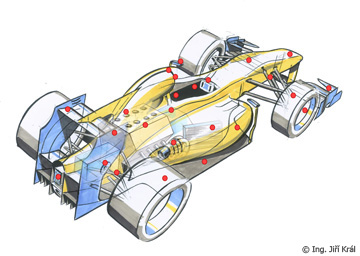Not even a moment to breathe for the Formula 1 braking systems at the Hungaroring
Alessandra Fedeli/ Brembo | 25.7.18 | Brembo F1 brzdy
Brembo F1 2018
Not even a moment to breathe for the Formula 1
braking systems at the Hungaroring
The 11 hard brakings for the Hungarian GP make great physical demands on the riders
Formula 1 returns to the Hungaroring (Hungary) theater from July 27 to 29, for the 12th appointment in the 2018 World Championship. The Hungarian track was one of the great intuitions of Bernie Ecclestone: he was the person who wanted to take Formula 1 to Eastern Europe countries.
The Hungarian circuit was inaugurated on March 24th 1986, and five months later it hosted the first Formula 1 GP. Compared to the original version, a chicane has been taken out and the Turn 12 design has been changed. The record on the track belongs to Sebastian Vettel (Ferrari), with a lap average speed of 207 km/h.
A low average compared to the other circuits (except for Munich), which shows the extreme windingness of the track and the need to use high aerodynamic load. The main exception is represented by the first turn after the finishing line which is preceded by a 790 meter straight.
According to Brembo technicians, who classified the 21 tracks in the World Championship, the Hungaroring circuit falls into the category of circuits presenting high difficulty for the brakes.
The demand on the brakes during the GP
So, as at Baku, brakes are used 11 times every lap; but the Azerbaigian track is 1,6 km longer. At the Hungaroring only 3 braking areas are extended to 2 seconds and they are all concentrated in the part of the track that is visible from the main stand. Every lap the brakes are in operation for 16 and a half seconds, that is the equivalent of 22% of the length of the race. Only the Munich GP (24%) and the Singapore GP (23%) has a higher percentage.
Average deceleration per lap is 4,1g, the same as at Baku, but compared to it the Hungarian track stands out because it does not have even one braking area with deceleration less than 3g.
The presence of so many bends results in the energy dissipated in braking being very high: 252 kWh, almost two times as much as Suzuka. This is the equivalent of the energy required for all the public lighting in Budapest for 11 minutes!
From the start line to the chequered flag each rider puts a total pressure of 92 tons on the brake pedal, among the highest in the World Championship 2017. A considerable effort for riders in addition to the high temperatures in this period. This value is the equivalent of the weight of 160 grey Hungarian cows!
The most demanding braking sections
Of the 11 braking sections at Hungaroring, 2 are classified as demanding on the brakes, 5 are of medium difficulty and the remaining 4 are light.
The hardest for the braking system is the first turn after the finish: the single-seaters arrive at a speed of 315 km/h and slow down to 95 km/h in just 132 meters. Riders exert a load of 142 kg for 2,73 seconds, and undergo a deceleration of 4,8 g.
The braking section at turn 12 is also very hard: speed plummets from 285 km/h to 123 km/h in only 1,93 seconds and 99 meters. The drivers are required to apply a remarkable amount of force: 4,8 g in deceleration and 145 kg load on the brake pedal.
On turns 8, 9 and 11 the brake is crucial to lose 20 km/h to 41 km/h of speed downshifting a gear: for each of these braking sections only 20 to 32 meters are needed, although the load on the pedal is not at all insignificant, ranging between 68 kg and 110 kg.
Brembo performance
The single-seaters with Brembo brakes have won 15 editions of the Hungarian GP, including the 2 editions renowned for the greatest comebacks at Hungaroring: in 1989 Nigel Mansell triumphed with Ferrari starting off in 12th position, and in 2006 Jenson Button established himself as leader with Honda, even if springing from the 14th box. With Brembo brakes everything is possible, even on the Hungaroring slide.




